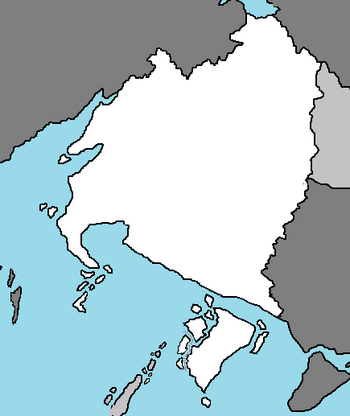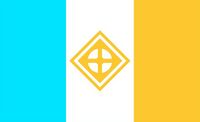Zoygaria
This article is incomplete because it is pending further input from participants, or it is a work-in-progress by one author. Please comment on this article's talk page to share your input, comments and questions. Note: To contribute to this article, you may need to seek help from the author(s) of this page. |
The Imperial Commonwealth of Zoygaria Sodružéstvo Imperiál de Zoyívska | |
|---|---|
| Motto: "Gens una, unus populus" | |
| Anthem: La Marszą de la Korona | |
 | |
| Capital | Vostok |
| Largest city | Akuí |
| Official languages | Zoygarian |
| Recognised national languages | Chestislavian, Shilagino, Nihonian |
| Ethnic groups (2014) | Zoygarian, Shilagino, Nihonian |
| Demonym(s) | Zoygarian |
| Government | Semi-Constitutional Monarchy |
• King | Arristok Zobieski III |
• Prime Minister | Sajto Solski |
| Legislature | La Praetoria |
| Skolja | |
| Šečo | |
| Population | |
• 2014 estimate | 57.8 million |
| Currency | Pavau |
| Time zone | |
| Date format | dd-mm-yyyy |
| Driving side | right |
| Calling code | +909 |
| Internet TLD | .zy |
Zoygaria, officially the Imperial Commonwealth of Zoygaria (Zoygarian: Sodružéstvo Imperiál de Zoyívska), is a Semi-Constitutional Monarchy located in Eastern Nortua in the Coalition of Crown Albatross. It is bordered by Irzemai to the north, the B.D.D.V. to the west, Versenia, Coaitte, and Gholjiet to the east, and shares maritime borders with Jumbosa, Archravia, and Jyau to the west and south respectively. Zoygaria is characterized by hilly, highly-varied elevation and terrain, dominated by low-lying mountains and hills, particularly in the southwest. The country is covered in vast expanses of plains and steppes with a broad coastline into the Nortua Sea and hundreds of islands, the largest of which is the island of Povoska. The Zoygarian climate is typically cool and mild in the summer months with biting winters that scourge the countryside in the latter half of the year. The Zoygarian capital is Vostok, the 4th-largest city, the largest being the historical city of Akuí, the metropolitan and cultural heart of the Imperial Commonwealth. Zoygaria has a population of approximately 57,801,000, making it the third-most populous nation in Nortua. Zoygaria is divided into 20 first-level subdivisions, with 18 Oblasts and 2 Grand Duchies, which are further subdivided into prefectures.
The Principality of Soyiv was founded in 1203 alongside the neighboring Helga and much larger Chestislava. In 1369, Soyiv and Helga unified, later merging with Chestislava under the Ovostek Agreement of 1456 and forming the Zoygarian Empire. The Zoyarian Empire would quickly establish itself as one of the strongest and most influential Nortuan powers, covering vast swathes of territory and establishing near-dominance of the Nortua Sea. The Empire would see a steady decline starting in 1684 due to a long series of devastating wars with little reprieve. The Zoygarian Empire collapsed in 1739 following the Great Zoygarian War after four grueling years of conflict that crippled the Empire and drained its treasury, effectively ending Zoygaria’s extensive influence. The Kingdom of Zoygaria would rise from the ashes of the Zoygarian Empire in 1740, implementing massive reforms in governance and finance. Zoygaria would go on to reclaim much of the mainland territory and local islands it had lost during the Great Zoygarian War, but would permanently lose most of its overseas colonies, which were left to fend for themselves after the Empire fell. In 1912, the Kingdom of Zoygaria underwent another major series of reforms, recognizing Archravian independence and establishing the Imperial Commonwealth. Zoygaria pursued an imperialist foreign policy, generally steering clear of binding alliances and organizations that threatened to hinder its autonomy, rising as a great power as a result of its formidable military and technology. Zoygaria developed its first nuclear weapons in 1979, cementing its position on the world stage and ensuring its continued influence over southeastern Nortua.
Etymology
The name Zoygaria is of Germanic origin, stemming from the German Zoigarien, meaning Zoygars, a term assigned by Besmenian cartographers who misinterpreted the name of the land. Thus, in English, the name Zoygaria means Land of the Zoygars, in reference to the people living there. The native name, Zoyívska, is a compound word of dual Latin-Slavic origin, much like the Zoygarian language itself. The word is the direct descendent of Soyiv, one of the predecessors of the modern Zoygarian state. Soyiv combines the Romance-derived Soi, meaning A variety of, with the Slavic iv, meaning of or from. This later evolved into Zoyívska as the Zoygarian language developed, adding the Slavic suffix ska, which has a very similar etymology to iv, but is more commonly in reference to a place, effectively translating to Land belonging to a variety (of people), most likely referring to the many peoples and proto-states that would eventually become Zoygaria.
History
Prehistory
The Principalities
In 1203, the newly-Christianized Latin-speaking tribes of modern-day Zoygaria formed the first feudalistic states along the coast of the Nortua Sea, with many stretching deeper into the heart of the continent. Among these were the early Principalities of Soyiv, Helga, Shilagi, and Vilecia, which had begun to form diverging cultures and languages. Soyiv and Helga in particular were influenced heavily by the neighboring Slavic tribes which held a much larger territory to the east, and would later be Christianized as Chestislava, named after the mythical Chestislav who settled the land. Each Principality was ruled by a single Prince to whom all the lords of the land swore fealty, and who in return would protect the lords’ lands with soldiers contributed to by said lords. Where before a unified culture and general harmony had existed between the fledgeling states, tensions now flared as the many Principalities began warring over territory.
Soyiv-Helga
In 1369, the Principality of Helga merged with the larger Soyiv, the two recognizing that their peoples were ethnically the same and that both spoke mutually-intelligible dialects of the same language, which was rapidly merging with the Chestislav language. The Prince of Helga swore fealty to the Prince of Soyiv, and Helga was incorporated into Soyiv, a state sometimes referred to as Soyiv-Helga. The now-bolstered Kingdom conquered Volagi and other surrounding areas in 1382 with the combined forces of the Soyiv and Helgan armies, and in 1400 conquered the Principality of Shilagi, seizing the capital city of Arcadia after a brutal siege. Soyiv saw a period of general peace and prosperity for the next few decades, trading extensively with the vast Grand Duchy of Chestislava and growing seaports along the Nortua Sea coastline. In 1456, the two unified under the Ovostek Agreement, merging the two now culturally-similar states and creating the Zoygarian Empire.
The Zoygarian Empire
The Golden Age
The creation of the first Zoygarian state led to a period from approximately 1478-1684 known as the Golden Age, a period in which Zoygaria rapidly grew in both size and influence, developing a powerful navy and setting up colonies abroad that further fueled the Empire’s growth. The cities of Etzio and Osovieç became Zoygaria’s principal seaports, with Etzio earning the nickname The Golden City. At its height, the Empire held 14 colonies under its administrative rule, defending them with its renowned military prowess. Zoygarian cartographers, linguists, and explorers embarked en masse to various locations across Iearth via Etzio and Osovieç, documenting lands across the world and leading to increased globalization within the Empire. The ideals and practices documented by these explorers greatly influenced the culture of the time as the population grew increasingly diverse. This globalization brought about radical changes to the governance of the Empire, leading to eventual religious tolerance and multilingualism among the territories of Zoygaria, as well as a complete restructuring of the various Krais, Oblasts, and Duchies.
Determined to establish footholds in valuable locations across the known world, the monarchy funded a great number of settlement and fortification projects across the seas, which often sparked wars and conflicts over the territories. Zoygaria pursued a policy of Dominum Marus Borealis, or Domination over the Nortua Sea, a philosophy of holding sea-supremacy of Zoygaria’s home waters and ports at all costs to protect the domestic interests of the Empire and to ensure that her colonies and trade abroad remained unmolested. This brought Zoygaria into frequent conflict with the rapidly-growing Constantio Empire, and, as a side effect of Zoygaria’s seafaring philosophy, whenever her grasp of the Nortua Sea was threatened, Zoygaria would divert ships and resources to the home front, often at the expense of her foreign colonies, the more threatened of which would sometimes capitulate as a result.
At some point beginning in the early 1500’s, a large exodus of people from an undetermined origin in Ausiana, theorized by scientists to be near modern-day Yuan, migrated to mainland and coastal Zoygaria, settling in large numbers there. They referred to themselves as the Nihonjin (Zoygarianized as Nihonžiski), hailing from a “Land of the Rising Sun” that the Zoygarians dubbed Švitkraína, or Dawnland. These Nihonian settlers arrived primarily in the ports of Etzio and Osovieç, where some remained, and others migrated further to the various coastal islands of Zoygaria and modern-day Archravia, the smaller of which were mostly uninhabited. These settlers established communities very similar to those they hailed from, and were allowed to practice their faith and speak their native language, though many eventually became Christian. They had a profound impact on coastal Zoygarian culture, influencing the Zoygarian language and establishing ethnic majorities on many islands and coastal regions.
Fall of the Empire
The Great Zoygarian War
The Kingdom of Zoygaria
Reconstruction
Archravian Independence
The Imperial Commonwealth
The World War
Project Švitkadita
The Zoyiv-Czeskodia War
Modern Era
Geography
Climate
Environment
Politics and government
Military
The Armed Forces of Zoygaria (Zoygarian: Las Forças Armatas de Zoyívska) or FAZ consist of four primary branches and one unincorporated branch: the Zoygarian Army (Zoygarian: La Tierra Vojna), Navy (Zoygarian: La Mara Vojna), Air Force (Zoygarian: La Astra Vojna), Elite Guard (Zoygarian: La Guardia de Élite), and the Royal Guard (Zoygarian: La Guardia Krolovski). The Commander-in-Chief of the FAZ is the ruling sovereign of the Imperial Commonwealth (currently King Arristok Zobieski III of Zoygaria), to whom all personnel must swear allegiance to in addition to the Imperial Commonwealth, with secondary power being afforded to the Secretary of Defence. The FAZ is tasked with maintaining the territorial integrity of the Imperial Commonwealth and her allies, maintaining security within the borders of the Imperial Commonwealth, and protecting the Imperial Commonwealth's interests abroad.
According to a 2021 report, all four primary branches were recorded to have a sum of 605,000 active-duty personnel, with the Reserves and Royal Guard increasing this number to 885,000 total personnel. The Imperial Commonwealth does have conscription laws in place, though conscripted personnel are relegated to the Reserves unless a state of war is entered, in which case a portion of the Reserves are transferred to active-duty. Zoygaria has a long history of military prowess with a particular focus on sea and air, and to this day maintains a large navy and air force, possessing 3 aircraft carriers, 1 of which is the experimental nuclear aircraft carrier Pustulka II. The Zoygarian military is almost entirely self-manufactured, primarily by companies such as Sukhoi, Mikojan i Gurevič, and the United Shipbuilding Corporation. Zoygaria's defence policy has oft mirrored its foreign policy, being deployed in the service of allies in need or wherever Zoygaria feels will best safeguard its interests. Zoygaria has its own nuclear weapons payload, developed in 1979 under Project Švitkadita.
La Tierra Vojna
La Mara Vojna
La Astra Vojna
La Guardia de Élite
La Guardia Krolovski
Foreign relations
Economy
Energy
Industry
Infrastructure
Transport
Demographics
Ethnicities
Education
Religion
Culture
Language
Music and art
Cuisine
Sports
Vexillology
Symbols
Navigation menu


